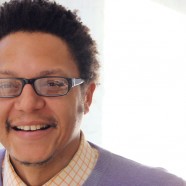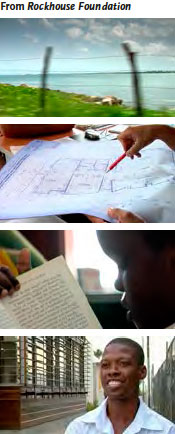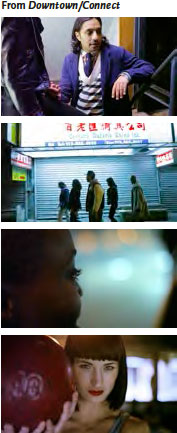
The Color Machine’s office is a Brooklyn artist’s loft: all open concept, complete with floor-to-ceiling windows, polished concrete surfaces and jangling elevator cage. The space is a comfortable blend of well worn and cutting edge—a perfect place from which filmmaker Raafi Rivero ’95 and his business partners to craft visual stories.
Raafi has worked in film and advertising since graduating from film school at Howard University. Prior to that, he studied film at Brown, and he’s been in New York City since. Two years ago, Raafi and Jordan Alport—filmmaker, friend and business partner—put their reels together and shared the collection with potential clients, showing that they were two people bigger than one. Both directors have well-honed filmmaking abilities and have produced their own work, but they were missing the necessary business acumen. Partner Liz Regan, a producer herself, came on to fill that gap. The Color Machine’s collective client list now includes global brands like Coca-Cola, Dior, Skype, McDonald’s and Quicksilver, as well as entertainment powerhouses like HBO, Sony and Discovery. Each production, regardless of client or product, gets at the heart of a human tale.
 The company’s site describes the trio as “a gang of makers.” While directors are assigned to projects according to client need and vision, collaboration is at the heart of their work. Together, they develop scripts, provide constant feedback, and ensure that the videos they release meet the same high-quality standards.
The company’s site describes the trio as “a gang of makers.” While directors are assigned to projects according to client need and vision, collaboration is at the heart of their work. Together, they develop scripts, provide constant feedback, and ensure that the videos they release meet the same high-quality standards.
“As a filmmaker, you need sounding boards,” Raafi says. “You might think a sequence or a cut works well, and someone else will watch it and say, ‘What does that mean?’ Having people you trust—who have a different perspective but great taste—look over your shoulder and share their opinions is essential.”
Raafi believes in two models of creativity: One he calls the Mozart model, where the boy genius writes the notes in his head because he innately knows how. The second model, and the one to which Raafi subscribes, he calls the Miles Davis model: “These people are still extremely talented, but the magic comes from putting Miles in the same room with John Coltrane, Bill Evans and Cannonball Adderley, and together they come up with Kind of Blue. From that collaboration—of talented people who trust their abilities—greatness bubbles up.”
Some of the creative process is instinctual, Raafi says: following an impulse that’s stronger than any other. However, he also depends upon his voracious appetite for information outside his own world. He purposefully consumes as much as possible each day—from culture, news, photography, technology, architecture, music, and the people in his life. Inspiration and ideas develop from those connections.
“You ultimately have to go back to your cave and tune everything out and say, ‘What do I believe? What ideas resonate?’ You need that spine, or strength of vision, but when you find moments of true collaboration you can be pleasantly surprised by your own work.”
Raafi recalls his early film work, when he was a college student with no money. Depending on limited resources and materials, he was forced to rely on what was abundant.
“When adapting becomes your zone, you begin to break apart every idea, and you often find something truly original,” Raafi says. “Film production is unruly. You’re always planning, scheduling, coordinating, but something inevitably goes wrong. You have to be flexible to solve those problems. You have to adapt to succeed.
 “Some of my biggest failures came when I didn’t admit that something wasn’t working. Ultimately, I pushed a piece that wasn’t good. No one wants to fail, but it’s a critical part of the process. It’s how you grow. In film you watch your work a million times—you have to find the right cut, the right moment. You’re always dying a thousand tiny deaths trying to get the footage to live up to the picture in your head.”
“Some of my biggest failures came when I didn’t admit that something wasn’t working. Ultimately, I pushed a piece that wasn’t good. No one wants to fail, but it’s a critical part of the process. It’s how you grow. In film you watch your work a million times—you have to find the right cut, the right moment. You’re always dying a thousand tiny deaths trying to get the footage to live up to the picture in your head.”
Leaving your comfort zone, Raafi says, is also key. “For a long time I was too focused on technique: how something looked, how to make the highest-quality image,” Raafi says. “I always admired friends or collaborators who start with the idea. I’m trying now to work explicitly in concepts. I used to be concerned with making a slick cut; now I’m much more concerned with what I’m communicating. I think that artists who serve ideas first have more to say, so I’ve been trying to build that into my process earlier. That doesn’t come naturally to me, though.”
One such artist that Raafi admires is Joe Carini, a high-end carpet maker in Tribeca. Joe travels the world collecting the finest materials for his rugs and tapestries, which retail in the tens of thousands of dollars. When Joe turned to Raafi for advertising inspiration, Raafi took him to an unlikely location. The Gowanus “Bat Cave” in Brooklyn is the abandoned central power station of the Brooklyn Rapid Transit. It has since become an illicit hub for inspired graffiti artists and a hideout for homeless of all ages. Grit, grime, street art and detritus cover the walls and floors. The contrast between the location and Joe’s carpets was alarming.
“Joe was game,” Raafi laughs. “He crawled into the Bat Cave with me and rolled out one of his $20,000 carpets onto the floor, which was covered in God-knows-what. He has the sensibilities of a young man who can find inspiration anywhere. I admire his ability to keep his mind alive. He’s my hero.”
Outside of his work at the Color Machine, Raafi is developing a feature film that he hopes to begin filming this spring. He’s been writing the heist movie, How to Steal, over the last two years. His previous short film, Their Eyes Were Watching Gummy Bears, is a coming-of-age comedy about two young African Americans about to graduate from Princeton. It has played in competition at more than 15 film festivals.
“When you’re used to creating films for ad agencies, your goal is three minutes or less. Working on a feature film, and walking onto the same set five days in a row, you’re able to draw connections between scenes rather than just executing one premise. Filming day after day is a test of your skills; it means getting past abstract apprehensions and getting elbow-deep in the elements of film itself—the actors, cameras, lighting, location, script—and actually making something.
“Film work combines many creative disciplines—writing, photography, costumes, music—which means compelling conversations with lots of smart, talented people. You have access to all these different fields in one. I don’t know of anything else as dense as filmmaking. That’s why I love it.”
— Erin Berg
RAAFI’S FAVORITES
Acclaimed American jazz musician and trumpeter Miles Davis: “He’s such a technically strong, talented musician—he plays a perfect A-flat—and still he was constantly reinventing himself.”
London-based disc jockey Gilles Peterson, known for his crate-digging style: “The man goes everywhere in the world. He’ll find this Tibetan yurt music, and when you hear it, it blows your mind. He has extremely eclectic taste; he’s one of my favorite cultural icons.” Blogger John Gruber, Apple-enthusiast and writer: “He writes about Apple the best of anyone I know. His Web site—daringfireball.net—is clean. I appreciate people who are the best at what they do, and he is.”
Film director and actor Spike Lee, best known for films Malcolm X, Do the Right Thing and Jungle Fever: “Spike Lee is a visionary. Whether you like his movies or not, they’re fun to watch. He packs so much visual information into his films, and his perspective is so unique.”
Director and screenwriter Michael Mann, known for The Last of the Mohicans, Collateral and Public Enemies: “He treats the subject of masculinity in a deeper way. He goes past the testosterone of the action and into the drama of the characters. His storytelling is so precise. His films are an education.”
Hong Kong filmmaker Wong Kar-wai, known for his visually unique and highly stylized work: “Wong Kar-wai makes the most romantic films out there. I could watch In the Mood for Love every day. I’ve read that he often works improvisationally, which can make the actors mad, but what you get in his films is emotional authenticity.”
Shepard Fairey, graphic designer and illustrator who emerged from the skateboarding scene, best known for creating President Obama’s “Hope” campaign poster: “He started with a simple perspective on street culture, and over the years he’s developed his work into art that is so rich, so thick and sticky. I like when street art rises to the level of high art, and he’s done that.”



